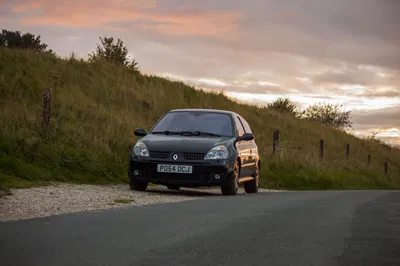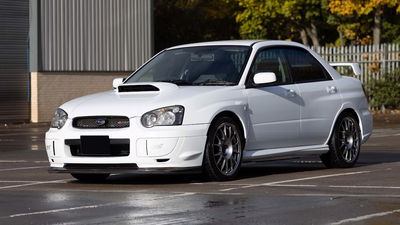10 Things You Need To Know Before Buying A Renault Sport Clio 172/182

After Car Throttle’s YouTube team was finished with a Renault Clio 182 from a cheap car challenge, the little French fighter stayed in the CT family. Social team member Edwin is now the proud owner of the car, but if you want to follow in his footsteps, there are some things you need to know before taking the plunge on one of these.
The earliest examples are now 20 years old, and all were made during a period when Renault wasn’t exactly famed for fastidious build quality. They’ve also gotten cheap enough to fall into the wrong hands.
With that in mind, here’s our 10-point buyer’s guide. Ignore this information at your peril…
There are myriad versions

Beyond the two main 172 and 182 versions of this car, there’s a dizzying array of derivatives.
It all started with the 172 Phase I, the only pre-facelift Mk2 RS. The Clio range’s 2001 mid-life refresh brought us the 172 Phase 2 with new looks, a marginally better interior and climate control. A year later the 172 Phase 2 Cup was launched with a wider track, Speedline Turini 16-inch wheels, a new splitter and a bigger rear spoiler. These could only be specced in Mondial Blue or Iceberg Silver and didn’t come with ABS.
In 2004 the 182 arrived as the 172’s replacement. The 2.0-litre F4R engine was retained, but with a new exhaust system and inlet manifold boosting the power from 170bhp to 180. Said exhaust features a distinctive twin centre-exit arrangement which runs through what used to be the spare wheel well. 182s also have cruise control, climate control and traction control.
The 182 Cup was launched simultaneously, with the same widened track and Turini wheels of the 172 Cup. You got ABS this time, as well as optional Recaro Trendline seats. The colour choices consisted only of Inferno Orange and Racing Blue.
The ultimate Mk2 RS is the 182 Trophy. These come with all the same stuff as the 182 Cup cars, but with the Recaros fitted as standard, and the standard dampers ditched for snazzier ones from Sachs. Only 500 came to the UK, all of which were finished in Capsicum Red.
Check for cambelt changes

As with pretty much every used performance car, service history is key with the 172 and 182. The engine is strong so long as regular oil changes have been done, recommended every year or 12,000 miles - whichever comes first. There are two other crucial elements in the history you need to look out for - the cambelt and the dephaser pulley.
The latter is a part of Renault’s variable valve timing system, and if the car is idling noisily when warm, it may be on its way out. The interval for the cambelt is 72,000 miles or every five years, and it’s worth changing the dephaser plus the water pump at the same time.
You’re looking at £600 - 800 to get all of that done at a specialist. That drops to £300 if you’re willing to do it yourself, but be warned - it’s not an easy job owing to the tight engine bay.
The interior is ropey

The exteriors of the various early hot Clios have aged pretty well. But the cabins? Oh dear. They look dated, they feel cheap, and yes, they rattle. The seating position is pretty poor as standard, which is why many go for aftermarket chairs or remove the spacers in the stock seats to drop them down a little.
Going for a 172 or 182 means accepting all of these interior foibles. If any of these is a deal-breaker, perhaps consider an R53 Mini Cooper S with its neat retro touches and comedy value giant speedometer.
Injectors are known to go over time

The fuel injectors used on these cars are a weak point, but there’s an easy way of seeing if a change is due. Crack out a multimeter and check the resistance after the car has been sat for a day or two - ideally it should be 14.1 ohms. If its lower than 13, consider replacement. A full set of the original Magneti Marelli injectors will set you back about £130.
Look out for jack damage

Take a close look at the sill jacking points for any damage. If a previous owner has been careless when jacking the car up, they may have crushed the drainage channels, which will cause water to pool inside the rear wings and cause rust.
A firm clutch is normal

Don’t be concerned by a heavy clutch pedal during a test drive - they all do that, sir. The clutch is self-adjusting, though, so the usual rules apply: a high biting point indicates you’ll need a new one soon. Clutch life expectancy is reasonable depending on how the car is driven - one should last for over 60,000 miles. You’ll need to budget about £700 to have this replaced at a specialist.
The gearboxes are weak

While the engine is reasonably strong (providing the service schedule has been kept up), the same can’t be said for the gearbox. If third gear is a little crunchy, this might indicate that the synchromesh is on its way out.
At that point, your best bet is a rebuild. This will cost around £300 - 500, similar to the cost of a used replacement gearbox, but still the better option. A second-hand transmission is likely to give you the same issues further down the line.
There are a few worthwhile upgrades

The 182’s mild steel, centre-exit exhaust is rot-prone and expensive to replace like-for-like, making stainless cat-back arrangements popular. You might want to upgrade the air filter at the same time, if nothing else for the noise - this being a naturally-aspirated engine, there aren’t easy power gains to be had.
Turbo conversions are around, but they’re prohibitively expensive and arguably spoil the car’s character. If it’s power you’re after, use the Clio’s turbocharged as standard big brother, the Megane 225, as a starting point.
Even the latest 182s are over 15 years old now, so you might want to think about new suspension components, opting for upgraded parts while you’re at it. If buying a new set of dampers, bear in mind your Clio’s spec - if it has a Cup chassis, the bolt spacing for the suspension is 60mm rather than 54mm.
But tyres come first

As we’re saying with increased frequency these days, no upgrade offers more bang for buck than a good set of tyres. You’re going to have to change them at some point anyway, and it’s well worth going for the best set you can. If going from a less than brilliant tyre to a premium option, the difference in lateral grip, traction and steering feedback will be noticeable, and for only a small outlay.
As the Clio has 16-inch wheels, you’re sadly missing out on the Michelin Pilot Sport 4 and the Goodyear Eagle F1 Asymmetric 5. Continental’s Premium Contact 6 does go down to 16s, though, and that’d be our choice. If you’re after something from Goodyear or Michelin in that size, it’d need to be an Eagle F1 Asymmetric 2 or a PS3. Good boots, but not as new or quite as impressive as the Contis.
The caveat is this applies to the 182, the tyre size for which is 205/45/16. For the 172, 195/45s are recommended. Go for some boots in that size, and all of the above options disappear, along with many of the decent mid-range performance tyres. For that reason, many 172 owners upsize to 205. Doing so can result in a little arch rub, though.
You'll need at least £2500 to good buy one, and some patience

Renault sold around 13,000 examples of the 172 and 182 combined, but time has been hard on these cars. As the hot hatch has dipped into the bargain end of the market, many have been neglected and or thrashed (and in many cases crashed) mercilessly on track. Tellingly, the numbers on How Many Left suggest more 172 Cups are SORN’d than are licensed for road use.
The surviving pool of hot 172s and 182s is drying up, and the days of getting a cheap but useable example are long gone. You might get lucky at the £2k mark, but £2500 is a more realistic starting point. Cars with the Cup pack carry a decent premium, while examples of the 182 Trophy can go for anything from £6000 to over £10,000 depending on the mileage and condition.















Comments
as a former Renault Mechanic i have to add this:
tell us about the megane R26? what are 10 things we need to know before buying one of those, especially if its our first french car